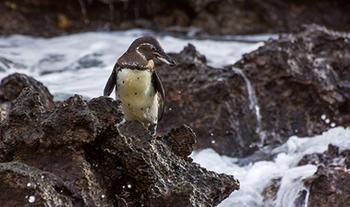Trouble in Paradise: Remote Location Is Not Immune from Micropollution
Jen Lynch, Erin Nelson, SETAC

An article recently published in Environmental Toxicology and Chemistry reports on microplastic pollution infiltration into the remote region of the Galapagos Islands.
In the article, “Ecotoxicological assessment of microplastics and cellulose particles in the Galápagos Islands and Galápagos penguin food web,” Karly McMullen and colleagues provide data to support the development and implementation of effective plastic pollution mitigation strategies to preserve the delicate ecosystem of this iconic UNESCO World Heritage Site. No studies prior to this had assessed the Galápagos penguin for microplastic exposure or microplastic ingestion through prey. Elsewhere, scat studies of Antarctic and sub-Antarctic penguins suggested a measurable microplastic ingestion by penguins of the Southern Hemisphere, including the popular and adorable Adélie and iconic King penguins.
The Galápagos penguin is an endangered seabird and top predator that has a small population of about 1,200 mature individuals distributed across the islands. It is the only penguin species in the near-equator region, and they have a limited foraging range, hugging the coast, usually less than one kilometer from shore. This makes the penguins susceptible to the high intensity and increasing frequency of El Niño-Southern Oscillation (ENSO) events and emerging pollution, including macro- and microplastics.
The good news is that despite the study finding surface seawater microplastics levels comparable to those near major coastal cities, there were no microplastics found in the limited penguin scat samples assessed. The study also found zooplankton ingested anthropogenic particles at particularly low levels. Most of the ingested particles found in fish remained unidentified, which emphasized the need for further research to understand their composition and origin. Microplastic pollution continues to threaten some of the world’s most iconic locations for marine biodiversity, and mitigation strategies are crucial in preserving locations like the Galápagos Islands and its inhabitants.
Author’s contact: [email protected]
